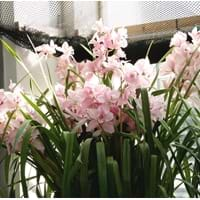Life Span
Perennial
Perennial
Type
Bulb or Corm or Tuber
Tender Perennial
Origin
South America
Southeastern Asia, China, Japan
Types
Pamianthe cardenasii , Pamianthe parviflora , Pamianthe peruviana
Cymbidium madidum, Cymbidium suave
Habitat
All sorts of environments
Open Forest, Rainforest, Woodlands
USDA Hardiness Zone
8-10
8-15
Sunset Zone
21,22
H1, H2, 14, 15, 16, 17, 18, 19, 20, 21, 22, 23, 24
Habit
Clump-Forming
Clump-Forming
Flower Color
White
Not Available
Flower Color Modifier
Bicolor
Not Available
Fruit Color
Green
Not Available
Leaf Color in Spring
Dark Green
Not Available
Leaf Color in Summer
Light Green
Not Available
Leaf Color in Fall
Several shades of Green
Not Available
Leaf Color in Winter
Light Green
Not Available
Leaf Shape
Strap shaped
Sword-like
Plant Season
Spring, Summer, Fall
Fall, Winter
Sunlight
Partial Sun, Partial shade
Partial Sun, Partial shade
Type of Soil
Loam, Sand
Sand
The pH of Soil
Acidic, Neutral, Alkaline
Acidic, Neutral
Soil Drainage
Average
Well drained
Bloom Time
Spring, Late Spring, Early Summer, Summer, Late Summer
Not Available
Tolerances
Drought
Not Available
Where to Plant?
Ground, Pot
Ground, Pot
How to Plant?
Offsets
Bulbs, Divison
Plant Maintenance
Medium
Medium
Watering Requirements
Keep the ground moist but not water-logged
Do not let dry out between waterings, Needs watering once a week
In Summer
Lots of watering
Lots of watering
In Spring
Moderate
Moderate
In Winter
Average Water
Average Water
Soil pH
Acidic, Neutral, Alkaline
Acidic, Neutral
Soil Type
Loam, Sand
Sand
Soil Drainage Capacity
Average
Well drained
Sun Exposure
Partial Sun, Partial shade
Partial Sun, Partial shade
Pruning
Pinch or prune as they grow to promote branching and bushiness, Remove damaged leaves, Remove dead branches, Remove dead leaves, Requires little pruning
Remove damaged leaves, Remove dead branches, Remove dead leaves
Fertilizers
All-Purpose Liquid Fertilizer, High phosphorus
All-Purpose Liquid Fertilizer
Pests and Diseases
Leaf spot, Mosaic viruses
Red blotch
Plant Tolerance
Drought
Drought
Flower Petal Number
Single
Single
Foliage Texture
Coarse
Not Available
Foliage Sheen
Glossy
Not Available
Self-Sowing
Yes
Not Available
Attracts
Bees, Birds, Bumblebees, Butterflies, Hummingbirds, pollinators
Bees
Allergy
Unknown
no allergic reactions
Aesthetic Uses
Beautification, Bouquets, Ornamental use, Showy Purposes
Cut Flowers, Landscape Designing, Showy Purposes
Beauty Benefits
No Beauty Benefits
Not Available
Environmental Uses
Air purification
Air purification
Medicinal Uses
No Medicinal Use
Cancer, Eye Problems
Part of Plant Used
Not Available
Whole plant
Other Uses
Beneficial species for attracting pollinators, Decoration Purposes
Air freshner, Employed in herbal medicine, Making Perfumes, Making Sweet Scented Oil, Oil is used for aromatherapy, Oil is used in perfume, soaps, creams, etc., Showy Purposes, Used As Food, Used as Ornamental plant, Used for fragrance
Used As Indoor Plant
No
Yes
Used As Outdoor Plant
Yes
Yes
Garden Design
Bog Garden, Container, Feature Plant, Foundation, Mixed Border, Water Gardens
Container, Cutflower, Hanging Basket, Houseplant, Rock Garden / Wall, Tropical
Botanical Name
HYMENOCALLIS longipetala
CYMBIDIUM
Common Name
Peruvian Daffodil, Spiderlily
Cymbidium Orchid, Sword-leaf Cymbidium, boat orchid
In Hindi
peruvian daffodil
आर्किड
In German
peruvian daffodil
Cymbidium Orchid
In French
peruvian daffodil
Cymbidium Orchid
In Spanish
Pamianthe
Cymbidium Orchid
In Greek
peruvian daffodil
kymbes
In Portuguese
peruvian daffodil
Cymbidium Orchid
In Polish
peruvian daffodil
Cymbidium Orchid
In Latin
peruvian daffodil
Cymbidium Orchid
Phylum
Magnoliophyta
Tracheobionta
Class
Liliopsida
Liliopsida
Order
Asparagales
Orchidales
Family
Amaryllidaceae
Orchidaceae
Genus
Pamianthe
Cymbidium
Clade
Angiosperms, Monocots
Angiosperms, Monocots
Tribe
Clinantheae
Cymbidieae
Subfamily
Amaryllidoideae
Epidendroideae
Number of Species
Not Available
Season and Care of Peruvian Daffodil and Cymbidium Orchid
Season and care of Peruvian Daffodil and Cymbidium Orchid is important to know. While considering everything about Peruvian Daffodil and Cymbidium Orchid Care, growing season is an essential factor. Peruvian Daffodil season is Spring, Summer and Fall and Cymbidium Orchid season is Spring, Summer and Fall. The type of soil for Peruvian Daffodil is Loam, Sand and for Cymbidium Orchid is Sand while the PH of soil for Peruvian Daffodil is Acidic, Neutral, Alkaline and for Cymbidium Orchid is Acidic, Neutral.
Peruvian Daffodil and Cymbidium Orchid Physical Information
Peruvian Daffodil and Cymbidium Orchid physical information is very important for comparison. Peruvian Daffodil height is 61.00 cm and width 61.00 cm whereas Cymbidium Orchid height is 30.00 cm and width 30.00 cm. The color specification of Peruvian Daffodil and Cymbidium Orchid are as follows:
Peruvian Daffodil flower color: White
Peruvian Daffodil leaf color: Dark Green
Cymbidium Orchid flower color: Not Available
- Cymbidium Orchid leaf color: Not Available
Care of Peruvian Daffodil and Cymbidium Orchid
Care of Peruvian Daffodil and Cymbidium Orchid include pruning, fertilizers, watering etc. Peruvian Daffodil pruning is done Pinch or prune as they grow to promote branching and bushiness, Remove damaged leaves, Remove dead branches, Remove dead leaves and Requires little pruning and Cymbidium Orchid pruning is done Remove damaged leaves, Remove dead branches and Remove dead leaves. In summer Peruvian Daffodil needs Lots of watering and in winter, it needs Average Water. Whereas, in summer Cymbidium Orchid needs Lots of watering and in winter, it needs Average Water.





